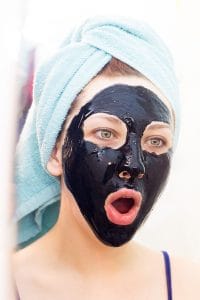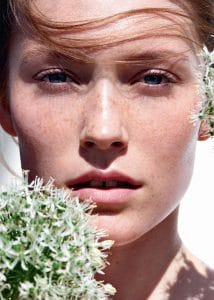Paula Begoun, the brains behind efficacious skincare brand Paula’s Choice, is on a lifelong mission to bust beauty myths. Coined “the cosmetics cop”, her approach is anti-gimmick and pro-transparency, informed by her 35-year career, centred on skincare.
When it comes to anti-ageing (a label which she’s fully for, by the way), Begoun focuses on facts over fads and shares some truths that we may not like, but our skin will. The below – all based on published research, not opinion – is advice to live by for younger looking skin. Over to the pro…

Photo: Harper’s BAZAAR
Myth #1: I should buy skincare products based on my age
You have probably seen products claiming to be designed for a specific age group (especially for women over the age of 49, who now suddenly have “mature” skin). But, age is not a skin type, and basing your skincare routine on this myth will not help your skin.
The truth? Someone who is 50 years old can have the same skin type and skin concerns as someone in their 20s or 30s. Oily skin, clogged pores, and breakouts don’t automatically go away when you turn 50; likewise, dry, dull-looking, uneven skin tone, signs of ageing (think sun damage), and skin discolourations can be a problem in your 20s and 30s. Regardless of your age, you should always choose your skincare products based on your skin type and skin concerns.
Myth #2: Anti-ageing products are only for when I’m older
It’s never too early to fight visible signs of ageing—the ingredients are the same for everyone, regardless of their age. It’s like your diet: What’s healthy for someone in their 30s is healthy for someone in their 60s.
If you’re worried that your skin will “adapt” to anti-ageing ingredients—that is, that they’ll stop working when you really need them— don’t be. Skin needs these vital substances at any age, and there’s no research to the contrary.
Some people are concerned that the ingredients in anti-ageing products might be too strong for younger skin—that is not the case.
The ingredients needed to fight signs of ageing may be potent, but they are suitable for nurturing skin of any age and there is no research anywhere in the world suggesting otherwise.
You should always choose skincare products based on your skin type and skin concerns. Determine what your skin needs based on how much sun damage, signs of ageing, dryness, or other skin concerns you have, not based on a fear that the ingredients you use now won’t work as you get older because it “adapts” to them or that they are too strong because of your age.

Photo: Getty Images
Myth #3: Skin colour matters when shopping for skincare products
When it comes to skincare needs, skin is skin—no matter the colour. Think of it like your diet: Regardless of your ethnic background, to be healthy we all need the same types of nutritious foods to supply antioxidants, vitamins, proteins, complex carbohydrates, and omega fatty acids.
There are some differences in skin of different ethnic backgrounds, such as skin thickness and the amount of melanin (brown pigment colour), but that does not affect the skincare products you need. When it comes to issues such as dry skin, clogged pores, acne, signs of ageing, sun damage, uneven skin tone, oily skin, sensitive skin, rosacea, and so on, the same types of ingredients are needed. Skin colour matters only when it comes to specific cosmetic corrective procedures performed by doctors. When it comes to skincare, the same ingredients work for the same skin concerns for everyone.
Also, don’t think that just because you have naturally darker skin colour you are protected from what the sun does to your skin. Unprotected sun exposure causes skin ageing and skin cancer, regardless of skin colour. These serious skin concerns may take longer to show up if you have darker skin, but the damage is still happening every minute of the day. Sunscreen is vital 365 days a year regardless of your skin colour.
Myth #4: Peptides and other skincare ingredients work like Botox
There is no research showing that any skincare ingredient in the world can work even remotely like Botox or any other cosmetic corrective procedures a physician performs. Even Botox won’t work like Botox if applied topically rather than being injecting into facial muscles.
If skincare products could work like Botox they’d be exceedingly dangerous. Just think, if a product “relaxed” or paralysed your facial muscles like Botox does, you wouldn’t want to apply it all over your face because it could lead to drooping and sagging. And, how would you be able to control application? Thankfully, that cannot happen!
That’s not to say that peptides aren’t remarkable ingredients as they have amazing benefits for skin, such as firming and evening out skin tone. Just don’t expect Botox-like results.

Photo: Bazaar UK / Florian Sommet
Myth #5: Skin needs different ingredients at night
We often see claims that skin needs different ingredients at night than it does during the day, but we haven’t seen one study supporting what those ingredients are or why they are needed. The only exception is skin’s need for sunscreen during the day.
You may have heard that your skin cell renewal rate is slightly higher at night than during the day (though that isn’t true for everyone), and this somehow means you need different products at night. Again, no reason is given as to why or what those ingredients are or how they benefit skin because of this increased cell renewal at night (and remember we’re talking about only slightly more cell renewal than during the day, barely statistically significant).
One of the more illogical reasons given for needing different ingredients at night is because skin is supposed to be more receptive to active ingredients at night than during the day. This certainly isn’t true about BHA or AHAs (which work the same way during the day as they do at night), hydrating ingredients (which moisturise skin the same way regardless of the time), and other bio-active ingredients, from peptides to retinol, which do their jobs no matter what the clock says. The truth? Cosmetic ingredients interacting with your skin can’t tell time!
How skin heals is also used as a reason for claiming that skin needs different products and ingredients at night than it does during the day. This is based on the belief that skin heals better at night, but recent research proves that is a myth and it turns out that skin heals faster during the day. That still doesn’t mean you need different ingredients during the day, it’s just an interesting myth to bust.
In short, other than sunscreen, skin can have the same beneficial ingredients applied during the day as it does at night, including antioxidants, skin-replenishing ingredients, cell-communicating ingredients, exfoliating ingredients, and hydrating ingredients.
Myth #6: Getting a base tan from a tanning bed before holiday prevents sunburn and sun damage
This myth is almost like suggesting you should smoke a cigarette to calm your nerves because that will reduce your stress (which is actually how cigarettes used to be advertised!). The research is clear: Cigarettes kill, no matter how temporarily unstressed you feel and UV rays from the sun or tanning beds and solariums are the same. It may feel or look good to get a tan but it’s damaging your skin nonetheless.
The research for solariums and tanning beds is 100% clear: They are toxic for skin. Many physicians describe solariums and tanning beds as “skin cancer beds”; in fact, the World Health Organisation has labeled indoor tanning as “carcinogenic” and many countries have banned them altogether or significantly restricted their use.
You may have heard that solariums and tanning beds are not as bad for your skin as the sun, but the truth is that solariums and tanning beds are considered worse because they emit concentrated radiation only inches from your skin. More important, indoor tanning bulbs emit mostly UVA rays, which reach deeper into skin and cause greater cellular damage than UVB or visible rays.
In short, tanning indoors might not seem as bad as being out in the sun, but just like sun exposure, the damage from tanning indoors is cumulative and it is killing your skin.
From: Harper’s BAZAAR UK



